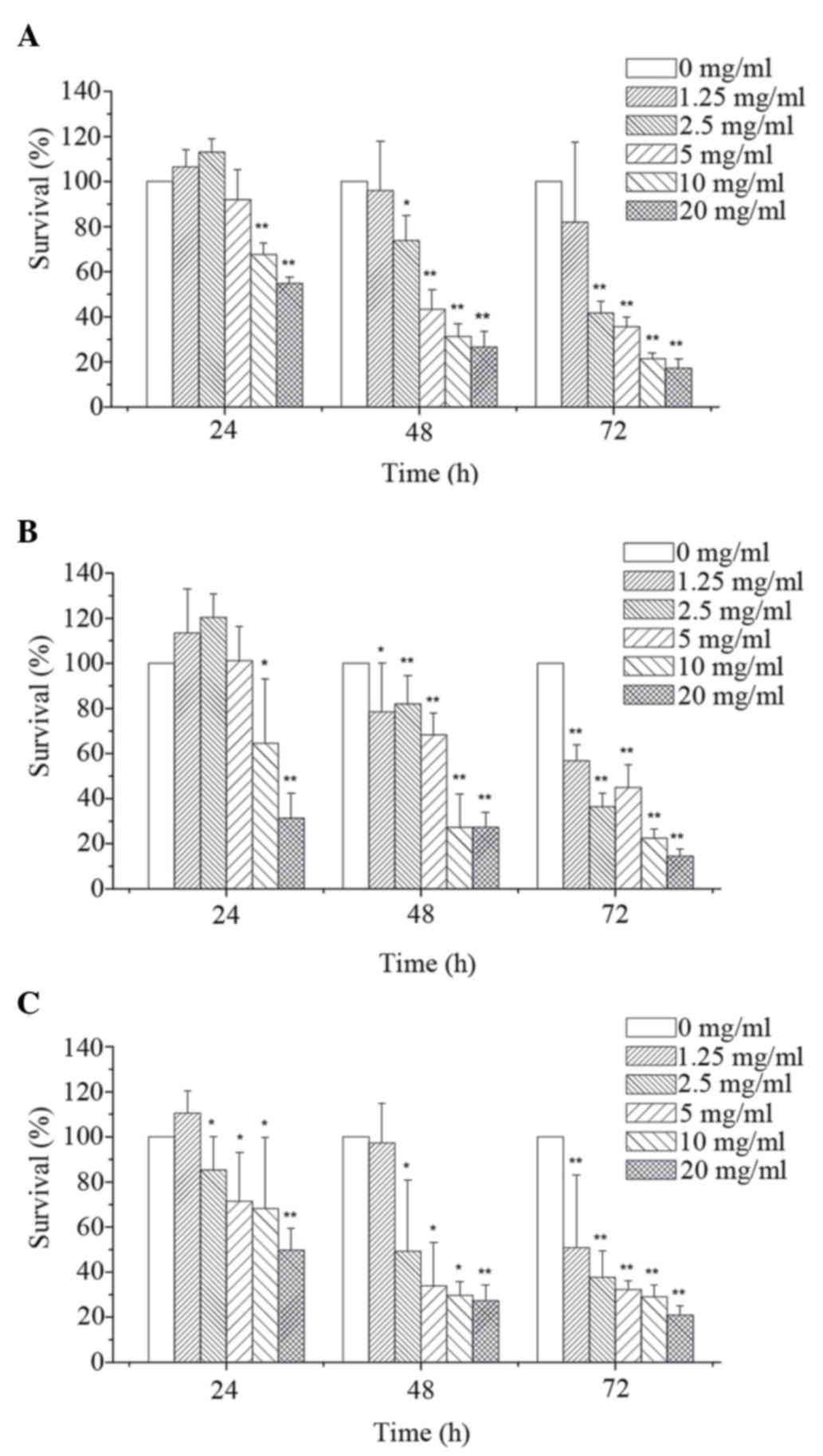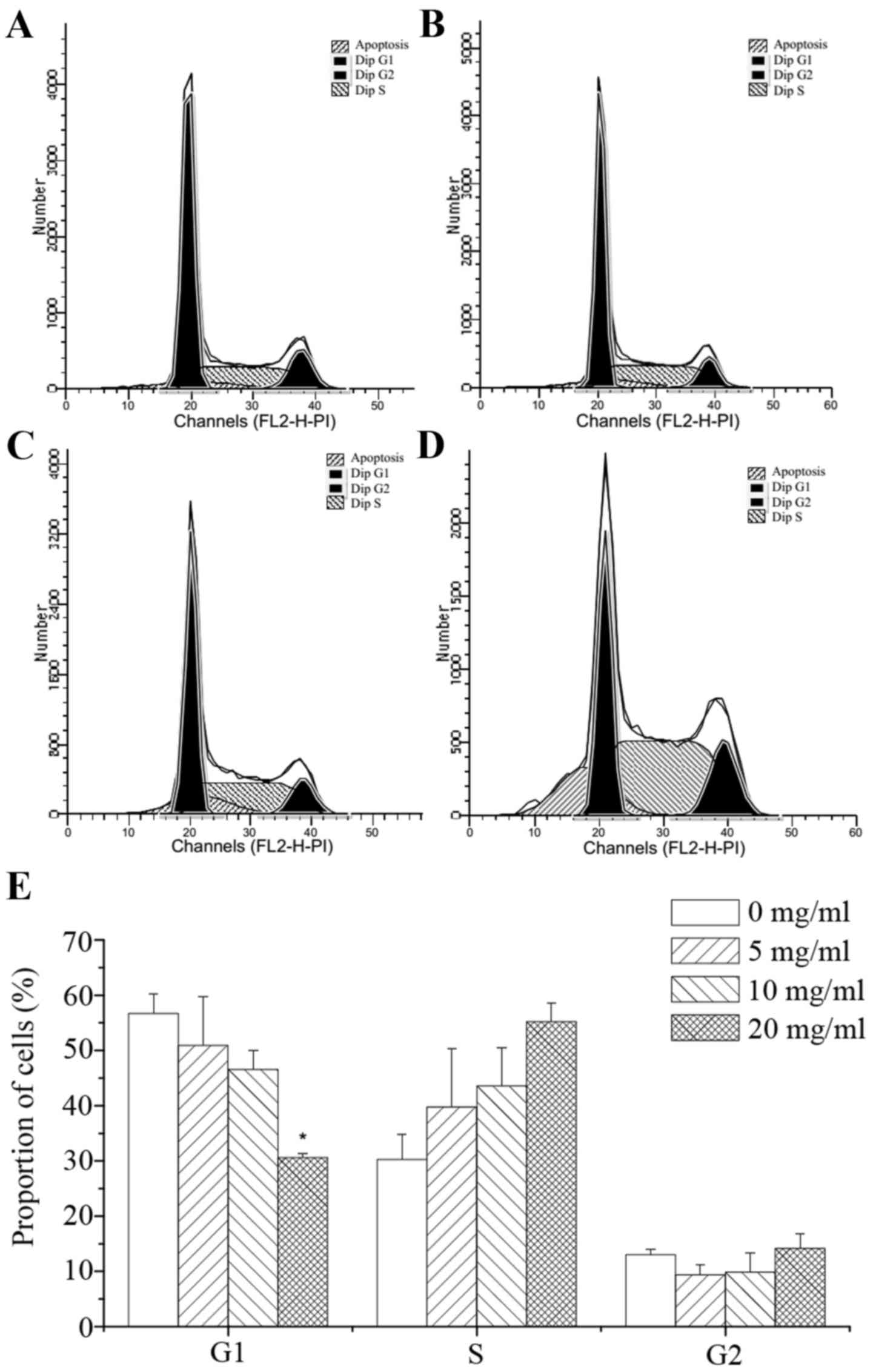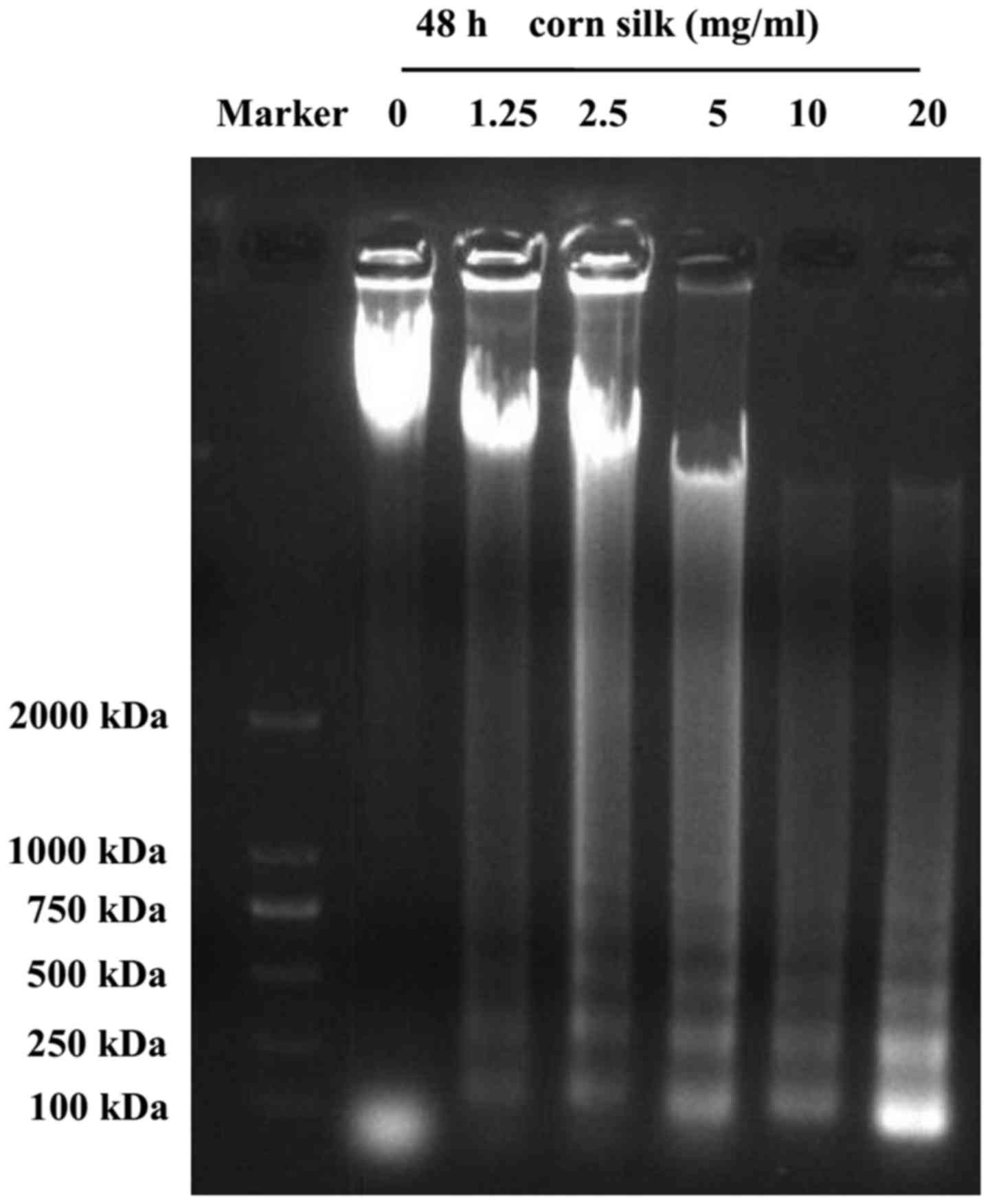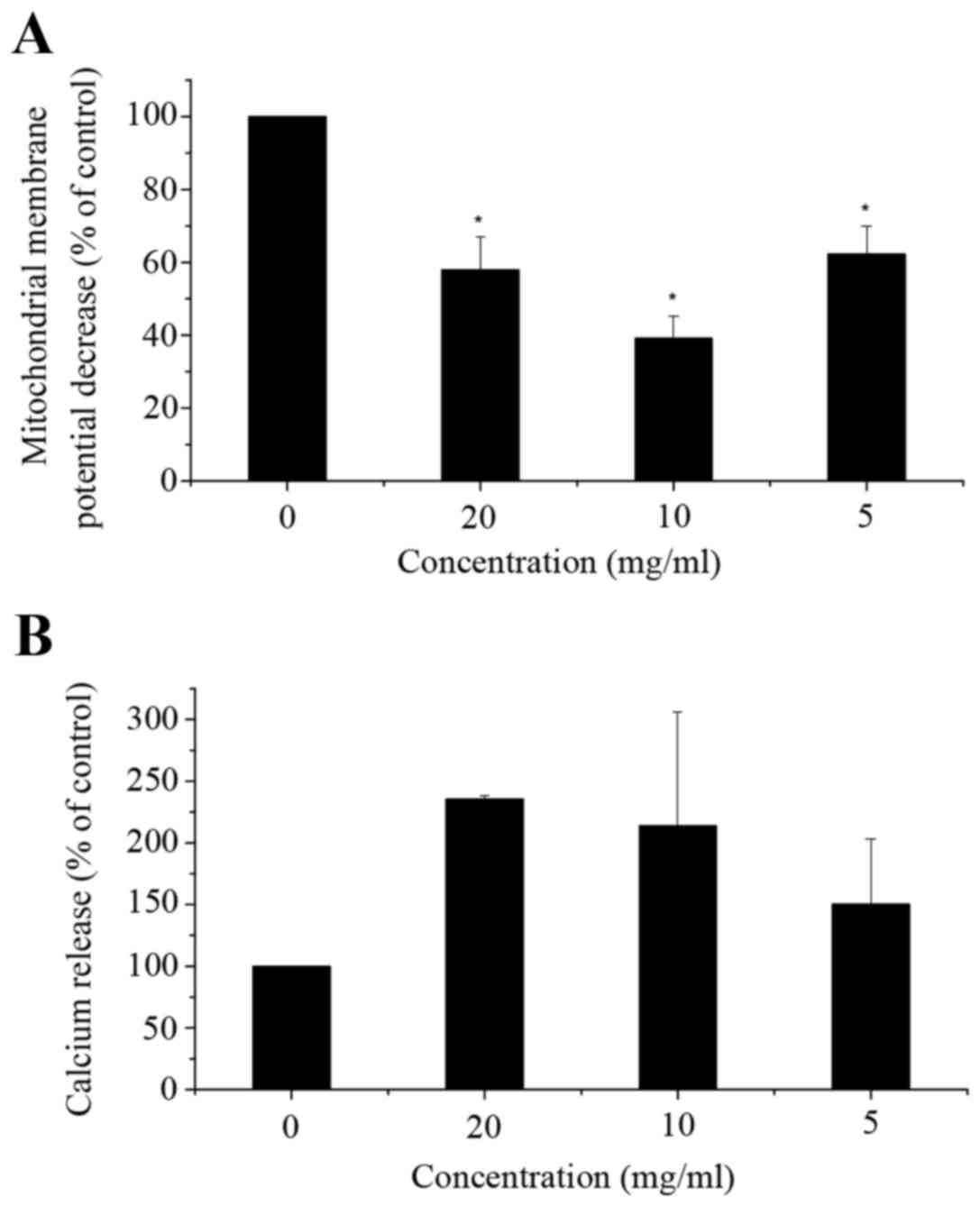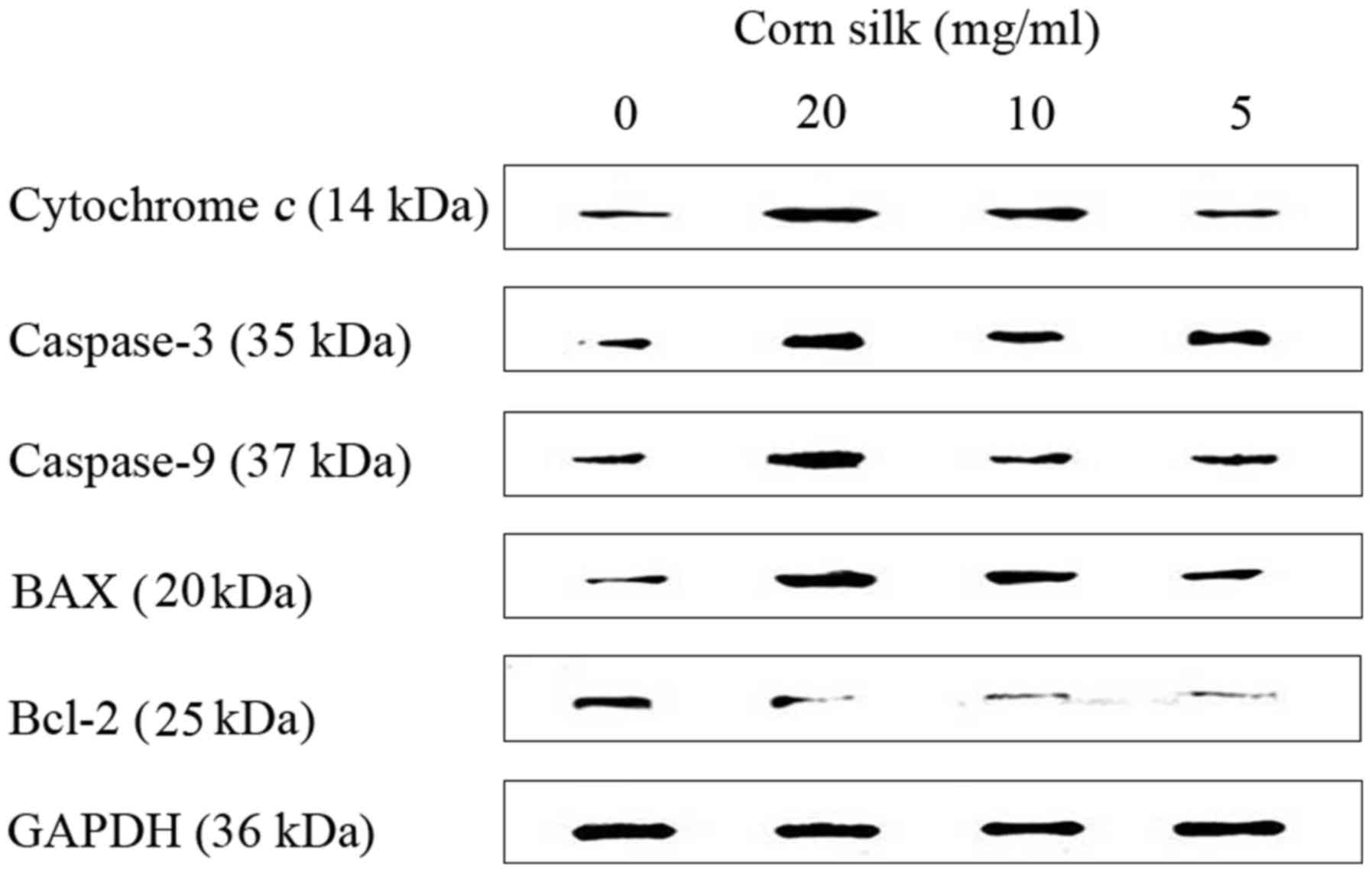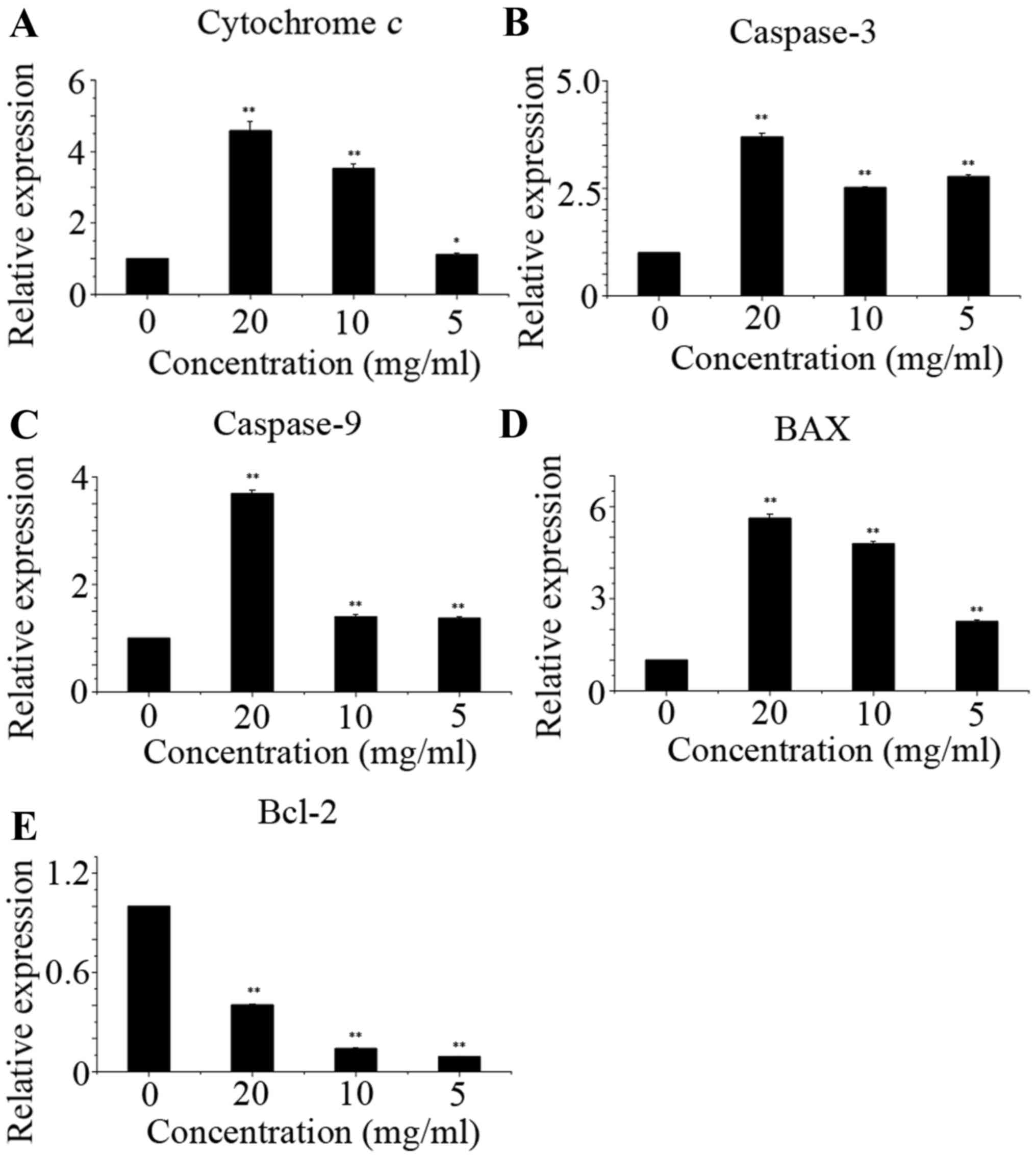|
1
|
Jiang QG, Li TY, Liu DN and Zhang HT:
PI3K/Akt pathway involving into apoptosis and invasion in human
colon cancer cells LoVo. Mol Biol Rep. 41:3359–3367. 2014.
View Article : Google Scholar : PubMed/NCBI
|
|
2
|
Patil JR, Murthy KN Chidambara,
Jayaprakasha GK, Chetti MB and Patil BS: Bioactive compounds from
Mexican lime (Citrus aurantifolia) juice induce apoptosis in human
pancreatic cells. J Agric Food Chem. 57:10933–10942. 2009.
View Article : Google Scholar : PubMed/NCBI
|
|
3
|
Hu QL and Deng ZH: Protective effects of
flavonoids from corn silk on oxidative stress induced by exhaustive
exercise in mice. Afr J Biotechnol. 10:3163–3167. 2011. View Article : Google Scholar
|
|
4
|
Chen S, Chen H, Tian J, Wang Y, Xing L and
Wang J: Chemical modification, antioxidant and α-amylase inhibitory
activities of corn silk polysaccharides. Carbohydrate polym.
98:428–437. 2013. View Article : Google Scholar
|
|
5
|
Zhao W, Yin Y, Yu Z, Liu J and Chen F:
Comparison of anti-diabetic effects of polysaccharides from corn
silk on normal and hyperglycemia rats. Int J Biol Macromol.
50:1133–1137. 2012. View Article : Google Scholar : PubMed/NCBI
|
|
6
|
Liu J and Mori A: Antioxidant and free
radical scavenging activities of Gastrodia elata Bl. and Uncaria
rhynchophylla (Miq.) Jacks. Neuropharmacology. 31:1287–1298. 1992.
View Article : Google Scholar : PubMed/NCBI
|
|
7
|
Namba T, Xu H, Kadota S and Hattori M:
Inhibition of IgE formation in mice by glycoproteins from corn
silk. Phytother Res. 7:227–230. 1993. View Article : Google Scholar
|
|
8
|
Habtemariam S: Extract of corn silk
(stigma of Zea mays) inhibits the tumour necrosis factor-alpha- and
bacterial lipopolysaccharide-induced cell adhesion and ICAM-1
expression. Planta Med. 64:314–318. 1998. View Article : Google Scholar : PubMed/NCBI
|
|
9
|
Hu QL, Zhang LJ, Li YN, Ding YJ and Li FL:
Purification and anti-fatigue activity of flavonoids from corn
silk. Int J Phys Sci. 5:321–326. 2010.
|
|
10
|
Lynch JM and Barbano DM: Kjeldahl nitrogen
analysis as a reference method for protein determination in dairy
products. J AOAC Int. 82:1389–1398. 1999.PubMed/NCBI
|
|
11
|
Rover MR, Johnston PA, Lamsal BP and Brown
RC: Total water-soluble sugars quantification in bio-oil using the
phenol-sulfuric acid assay. J Anal Appl Pyrolysis. 104:194–201.
2013. View Article : Google Scholar
|
|
12
|
de Wit JN: Marschall Rhône-Poulenc Award
Lecture. Nutritional and functional characteristics of whey
proteins in food products. J Dairy Sci. 81:597–608. 1998.
View Article : Google Scholar : PubMed/NCBI
|
|
13
|
Tai KW, Chou MY, Hu CC, Yang JJ and Chang
YC: Induction of apoptosis in KB cells by pingyangmycin. Oral
Oncol. 36:242–247. 2000. View Article : Google Scholar : PubMed/NCBI
|
|
14
|
Lu HF, Lai TY, Hsia TC, Tang YJ, Yang JS,
Chiang JH, Lu CC, Liu CM, Wang HL and Chung JG: Danthron induces
DNA damage and inhibits DNA repair gene expressions in GBM 8401
human brain glioblastoma multiforms cells. Neurochem Res.
35:1105–1110. 2010. View Article : Google Scholar : PubMed/NCBI
|
|
15
|
Lin SY, Lai WW, Ho CC, Yu FS, Chen GW,
Yang JS, Liu KC, Lin ML, Wu PP, Fan MJ and Chung JG: Emodin induces
apoptosis of human tongue squamous cancer SCC-4 cells through
reactive oxygen species and mitochondria-dependent pathways.
Anticancer Res. 29:327–335. 2009.PubMed/NCBI
|
|
16
|
Lu HF, Chen YS, Yang JS, Chen JC, Lu KW,
Chiu TH, Liu KC, Yeh CC, Chen GW, Lin HJ and Chung JG: Gypenosides
induced G0/G1 arrest via inhibition of cyclin E and induction of
apoptosis via activation of caspases-3 and −9 in human lung cancer
A-549 cells. In Vivo. 22:215–221. 2008.PubMed/NCBI
|
|
17
|
Wu CC, Lin JP, Yang JS, Chou ST, Chen SC,
Lin YT, Lin HL and Chung JG: Capsaicin induced cell cycle arrest
and apoptosis in human esophagus epidermoid carcinoma CE 81T/VGH
cells through the elevation of intracellular reactive oxygen
species and Ca2+ productions and caspase-3 activation. Mutat Res.
601:71–82. 2006. View Article : Google Scholar : PubMed/NCBI
|
|
18
|
Mohan KV, Gunasekaran P, Varalakshmi E,
Hara Y and Nagini S: In vitro evaluation of the anticancer effect
of lactoferrin and tea polyphenol combination on oral carcinoma
cells. Cell Biol Int. 31:599–608. 2007. View Article : Google Scholar : PubMed/NCBI
|
|
19
|
Zheng L, Wang X, Luo W, Zhan Y and Zhang
Y: Brucine, an effective natural compound derived from nux-vomica,
induces G1 phase arrest and apoptosis in LoVo cells. Food Chem
Toxicol. 58:332–339. 2013. View Article : Google Scholar : PubMed/NCBI
|
|
20
|
Ooi VE and Liu F: Immunomodulation and
anti-cancer activity of polysaccharide-protein complexes. Curr Med
Chem. 7:715–729. 2000. View Article : Google Scholar : PubMed/NCBI
|
|
21
|
Yang J, Li X, Xue Y, Wang N and Liu W:
Anti-hepatoma activity and mechanism of corn silk polysaccharides
in H22 tumor-bearing mice. Int J Biol Macromol. 64:276–280. 2014.
View Article : Google Scholar : PubMed/NCBI
|
|
22
|
Lee J, Lee S, Kim SL, Choi JW, Seo JY,
Choi DJ and Park YI: Corn silk maysin induces apoptotic cell death
in PC-3 prostate cancer cells via mitochondria-dependent pathway.
Life Sci. 119:47–55. 2014. View Article : Google Scholar : PubMed/NCBI
|
|
23
|
Fan MJ, Lin YC, Shih HD, Yang JS, Liu KC,
Yang ST, Lin CY, Wu RS, Yu CS, Ko YC and Chung JG: Crude extracts
of Agaricus brasiliensis induce apoptosis in human oral cancer CAL
27 cells through a mitochondria-dependent pathway. In Vivo.
25:355–366. 2011.PubMed/NCBI
|
|
24
|
Wang L, Hu T, Shen J, Zhang L, Li LF, Chan
RL, Li MX, Wu WK and Cho CH: Miltirone induced mitochondrial
dysfunction and ROS-dependent apoptosis in colon cancer cells. Life
Sci. 151:224–234. 2016. View Article : Google Scholar : PubMed/NCBI
|
|
25
|
Abdel-Latif AM, Abuel-Ela HA and
El-Shourbagy SH: Increased caspase-3 and altered expression of
apoptosis-associated proteins, Bcl-2 and Bax in lichen planus. Clin
Exp Dermatol. 34:390–395. 2009. View Article : Google Scholar : PubMed/NCBI
|
|
26
|
Su TR, Tsai FJ, Lin JJ, Huang HH, Chiu CC,
Su JH, Yang YT, Chen JY, Wong BS and Wu YJ: Induction of apoptosis
by 11-dehydrosinulariolide via mitochondrial dysregulation and ER
stress pathways in human melanoma cells. Mar Drugs. 10:1883–1898.
2012. View Article : Google Scholar : PubMed/NCBI
|
|
27
|
Wu Z, Liu B, Cailing E, Liu J, Zhang Q,
Liu J, Chen N, Chen R and Zhu R: Resveratrol inhibits the
proliferation of human melanoma cells by inducing G1/S cell cycle
arrest and apoptosis. Mol Med Rep. 11:400–404. 2015.PubMed/NCBI
|



